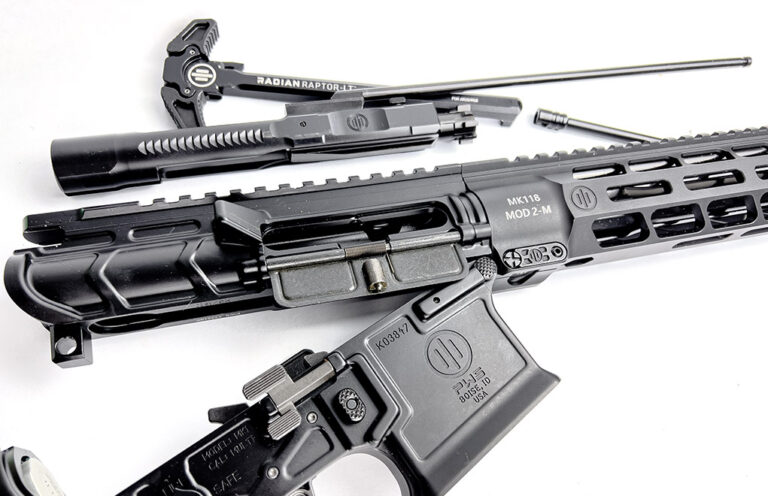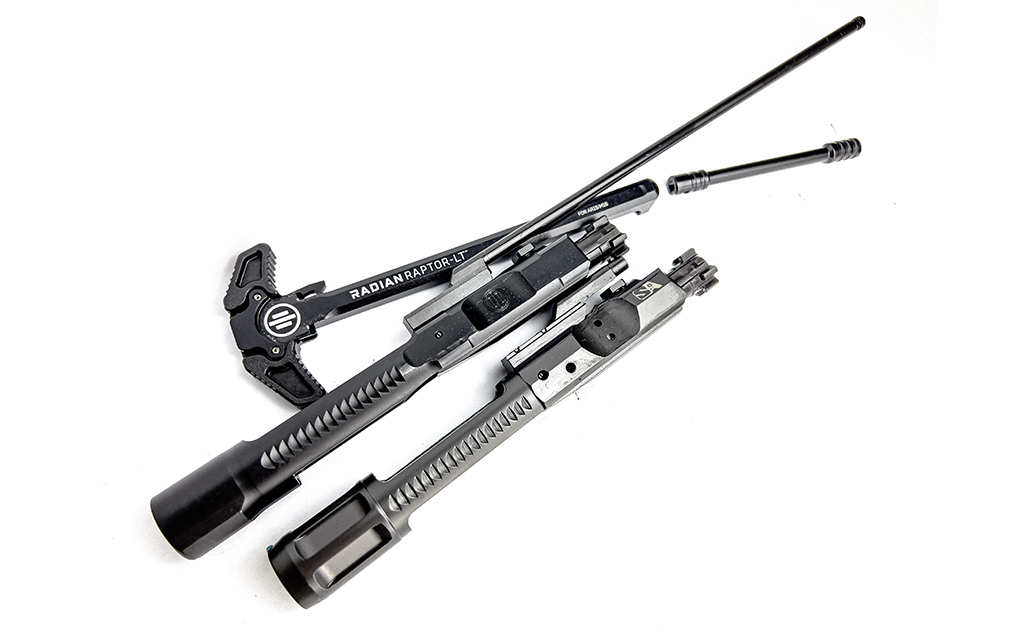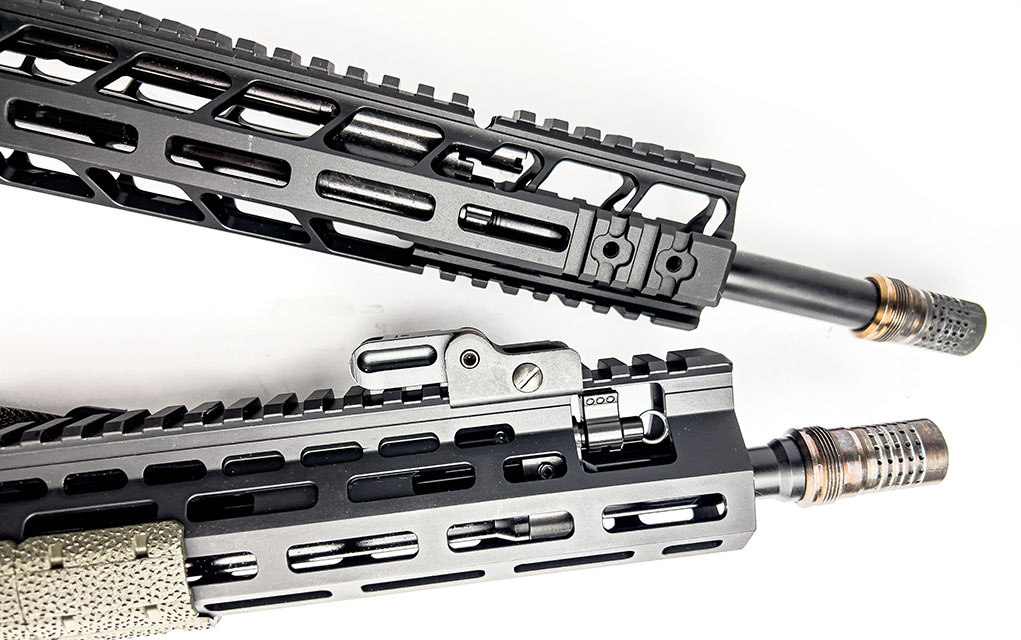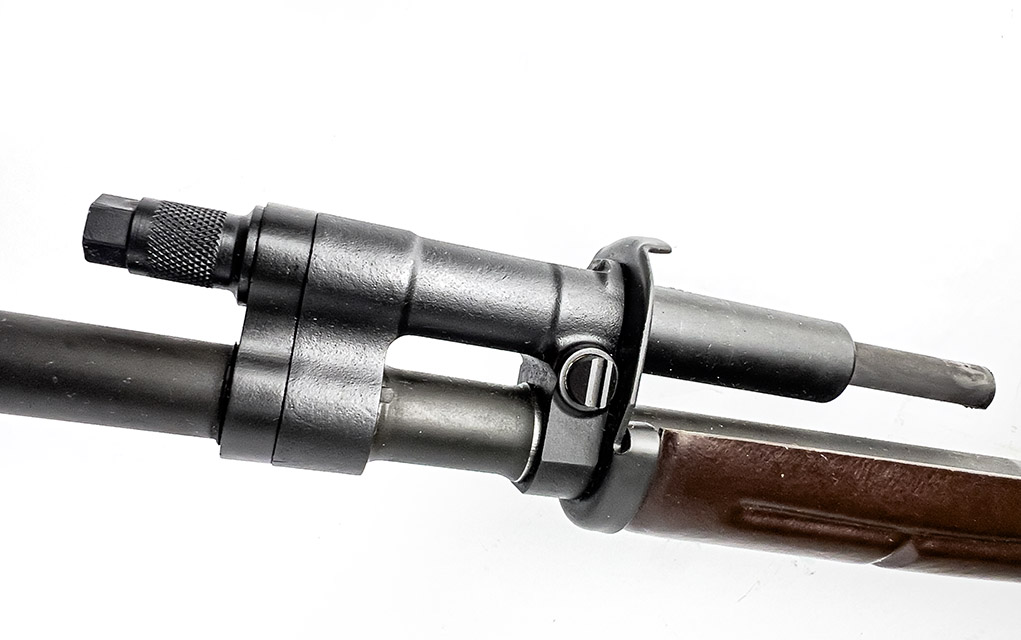
How do self-loading rifles function? There are different ways, but here I break down the major types of rifle gas systems.
It’s fair to assume that most shooters have at least a general understanding of how their guns work on a technical level. The ins and outs of specific designs can be a fairly specialized knowledge set, but I’d wager that most people using common semi-autos know they are, in large part, gas operated.
However, there is quite a bit of nuance that we’re going to dive into here talking about the various gas systems and how they work, especially with suppressors and how things like gas flow and bleed-offs work. This is a technical topic, but I’ll spare the jargon and try to relay as much of this as possible in layman’s terms so everyone ends on the same page.
Gas System Types
For what we’re talking about here, we’re going to be discounting such rifles as bolt actions and anything manually operated. There are, of course, ways that gas interacts with these guns and suppressors, but those are their own topic. Specifically, we’re going to look at direct gas and piston-operated rifles, each with its own problems and advantages.

The baseline situation with these guns is that the rifle operates using a port in the barrel that acts as an avenue for gas pressure to be directed. If you are new to this topic, yes, there is in fact a hole in the barrel that is drilled through into the bore itself. This hole is typically called the gas port. A gas block is mounted to this—a fixture that is the interaction point between the barrel and whatever gas system is in use. The shape and style of the gas block varies depending on what is being asked of it, but for our purposes we’re going to look at it as a very important piece of this equation.

Before we go too far into gas blocks, we need to look at operating systems. At a point, their function is well-established, and I’ll only go into a brief discussion on their designs to save space here. The two basic forms mentioned above are both in common use, with direct gas being the more common today in the AR platform.
Direct-gas guns take the gas pressure from the firing cycle and vent it through the gas block into a thin metal tube, of course called a gas tube. This little tube takes the gas pressure built up in it and blasts it directly into the gas key, a hollow structure atop the bolt carrier group. This gas pressure forces the bolt carrier group rearward, thus unlocking the bolt, ejecting the spent cartridge, and then, by spring power, travels forward to strip a fresh round off the magazine, thus starting the cycle again.
The downside of this otherwise reliable method of gas operation is that it is, comparatively, very dirty. When firing suppressed, the average AR becomes a mess very quickly. I have been firing all my AR rifles suppressed now for years, and fouling in the guns is about 10 times worse than firing unsuppressed. Your mileage may vary … but be prepared to do a lot of cleaning. I’m not above just blasting out an AR with a hose and Dawn soap in the backyard.
Piston rifles, by design, are much cleaner in operation. There are endless debates about the reliability of piston guns over direct-gas guns. But the jury is permanently out, as the entire world uses variations of both systems with many nations, including our own, using both in various capacities.
Piston rifles vary a lot in terms of design; some use a fixed piston, such as the AK series rifles, and others have a push rod system where the bolt group is separate from the piston. A rod in the gas tube will push the carrier back. Some argue this is better from the standpoint of maintenance and reduced bolt carrier mass for softer cycling, but again, the jury is out.
There are too many successful designs out there that use fixed pistons or push rods, and all of them are pretty good … just different. In either case, the vented gas is used to actuate the piston in what amounts to a closed system, thus keeping propellant gas out of the receiver. Wisdom says that this is more ideal for suppressor use in that it keeps the interior of the gun very clean. In my personal experience, I have found this to be largely true and have come to enjoy the lack of cleaning piston guns offer.
Staying In Tune
The commonality among these systems, aside from being gas operated, is how we can alter the flow of this gas to change the internal pressure in the gun. It works in largely the same way regardless of a rifle being direct gas or piston.
That said, piston guns are somewhat less flexible in how they interact with the gas cycle. While not the rule entirely, rare is a single piston system that’s as modular as the direct gas system on the AR platform. Most piston guns are designed to work only as their set specs allow and are often from a single manufacturer.

For instance, the BRN 180 is a piston gun, and so is the FN SCAR. They are in no way compatible, and there isn’t anything that can be done on a real level to affect the way these guns work in terms of reliable cycling. You pretty much get what you get; you can regulate the system by reducing the amount of gas … and therefore pressure in the system.
The AR series is quite the opposite. There are many distinct gas system lengths that are quite modular, and you can select the type of gas system you need for your individual build. The shorter the gas system, the higher the initial operating pressure. This is why many shorty builds feel snappy compared to a 20-inch barrel with a rifle-length gas system, a combination most regard as very smooth and easy to shoot.
The AR can also be adjusted by using a lightweight bolt carrier and various weights of buffer to achieve the desired balance in the gun. Depending on the cartridge you’re using, you will want to pick a gas system based on what kind of pressure it uses, such as .300 Blackout, which is best with a very short gas system due to its sometimes very minimal powder charges in subsonic form. It often won’t generate enough pressure to cycle the action without a suppressor to help.
A problem that can exist in some cases is over-gassing, especially with suppressor use. What we don’t want is to take a rifle that has a gas system regulated for unsuppressed use and then create a situation where the gun is beating the hell out of itself. Bleeding off gas is the way to solve this, and in some cases with more modular platforms like the AR, you can select different internal parts to help slow the bolt travel, making it less violent.
While most guns won’t be horribly damaged by over-gassing, it isn’t a great idea and can pretty easily result in parts wearing out quickly. Now, of note if you are using a suppressor, this means that in some cases your rifle will need the suppressor installed to cycle properly. Ideally, your adjusted gas system will kick all your brass out nicely in the same spot. A symptom of over-gassing is erratic brass ejection. When I tune my gas systems, I can expect the rifle to be very gentle in the firing cycle and drop brass consistently in the same area.
It’s surprising how little gas you need to cycle a suppressed semi-auto. Some of my rifles will still cycle unsuppressed, but ejections are weak, and the bolt may not lock back. Many rifles have a factory installed gas selector that lets you switch essentially between “suppressed” and “unsuppressed.” In reality, this is a basic gas bleed-off that keeps it simple for the causal shooter.

If you are a dedicated suppressor shooter, you’ll want a more finely adjustable gas block that allows you to really dial in your pressure curve inside the gun for best handling and therefore function. A suppressed semi-auto rifle with a properly adjusted gas system should feel smooth and run like a sewing machine with no “thumping” as the bolt moves. In calibers like 5.56 NATO, you can work this to make your rifle have virtually no felt recoil, sometimes to the point of it not moving at all. This is especially great when hunting smaller game at longer ranges and with thermal optics.
Tuning gas systems on unsuppressed rifles can offer a number of benefits—not so much on direct gas rifles, but on piston guns especially. Many piston rifles are almost over-gassed from the factory and could do for a calming down. Military-based piston rifles are known to cycle hard and for good reason, they are often asked to work with whatever 5.56 or 7.62 NATO is laying around, and it’s better to err on the side of function.
The M14 rifle is one that strongly benefits from an adjustable gas plug (note that the M14 has a separate screw-in plug that caps off its gas system), and it can be regulated to be very smooth, especially for match shooting. On these types of rifles, you can really extend the life of parts by smoothing out the system pressure. In the M14 especially, which can be an extremely accurate rifle in defiance of many known accuracy trends, a smoother cycling action just makes it that much more able to compete and shoot with.

My own M14 is a Fulton Armory rifle. They recently sent me their brand-new muzzle thread adapter and an adjustable gas plug to allow suppressed use with the rifle, itself featured in many of my Gun Digest topics. When I started to use the rifle suppressed, I was immediately impressed with the difference the upgrades made. The M14 is already soft-recoiling for a .308/7.62 rifle, but with the suppressor and FA adjustable plug, it was easy to get it down to nearly unnoticeable levels of recoil. Having shot CMP sports for most of my life locally and at Camp Perry, I can’t imagine a better match-shooting machine than this.
Notable Aftermarket Gas System Parts
I have a lot of miles on the suppressed SCAR system. The SCAR has a reputation for being hard on optics, and a good amount of this lore comes from the early days it was in use. A cursory internet search shows hundreds of forum posts about SCAR owners breaking scopes. The SCAR 20S that has appeared on these pages boasts a small but necessary part—an adjustable gas plug called the SCARburator from Mototech Engineering. This little part absolutely changes the SCAR for the better and is arguably a must for shooting the SCAR suppressed.

The SCAR is a very modular platform but isn’t widely owned by comparison to the AR-15 and AR-10 class rifles. I really like it in general … if I can adapt the lower for SR25 mags in .308. This single part is a must for any SCAR owner in my opinion, on the merit of how these guns handle their gas pressure. While not exactly cheap at $149, these aren’t cheap guns anyway. Just get one.
Superlative Arms might be the biggest player on the block when it comes to blocks … of the gas variety. When I get guns from the factory, I typically don’t mess with them much, but most guns you see in my photography on these pages I put together myself. I not only build them for photos, but I really do also use them in the field. Range use only does so much, and I believe in only featuring parts and guns that I would personally trust if I was in adverse conditions.
Superlative gas blocks are very easy to use and install, and they come in a variety of finishes. All my direct-gas guns, aside from historical and military builds, have them installed. They operate simply and have a “click” adjustable plug that allows you to repeatably tune your gas system. When bottomed out, the gas is off, and basically you’d have a straight-pull bolt action.
I typically bottom them out as a starting point, and then I open it five clicks to start. You can go one at a time, but in my use of these blocks, five is the minimum to cycle with a rifle-length gas tube and suppressor.
Of note is that Superlative also makes some very smart parts. Their bolt carrier has an internal chrome lining, which is incredible for suppressed use. I hate cleaning my bolt carriers, but it’s a must for good operation, and the fact that they hard chromed the inside of it makes my work so much faster and easier. It’s honestly a great feature across the board that I don’t know why it isn’t standard.
Gassed Out
As we march forward in terms of technology and knowledge in our industry, the pioneers will always be somewhat alone on the frontier … waiting for the rest to catch up. We are in a good place now when it comes to our understanding of gas-operated rifles, but the future will undoubtedly hold a much higher degree of standardization for use to perfect and then continue to expand upon.
The products in this article are decidedly aftermarket and will need to be worked on by you, the home builder. The sheer number of products out there, combined with the endless variety of suppressors and ammunition types, makes it so that this discussion is somewhat personal and truly up to you for the time being. Your mileage will vary depending on your chosen end use, but if you are in the business of playing with suppressors and getting your rifles cycling smooth, you need the ability to alter your gas flow—that much is certain.
Editor's Note: This article originally appeared in the July 2025 issue of Gun Digest the Magazine.
Get On Target With The AR:
- Best Budget AR-15 Options And Buyers Guide
- Go Small With These 8 Economical AR Pistol Options
- AR-10 vs. AR-15: How Stoner’s Rifles Stack Up
- AR-15 Lower: Putting The Internals Together
- How It Works: The AR Upper
- Top AR-15 Upgrades From Top To Bottom
- Upgrades: Top AR-15 Parts

Next Step: Get your FREE Printable Target Pack
Enhance your shooting precision with our 62 MOA Targets, perfect for rifles and handguns. Crafted in collaboration with Storm Tactical for accuracy and versatility.
Subscribe to the Gun Digest email newsletter and get your downloadable target pack sent straight to your inbox. Stay updated with the latest firearms info in the industry.

![Best Concealed Carry Guns In 2025 [Field Tested] Wilson Combat EDC X9S 1](https://gundigest.com/wp-content/uploads/Wilson-Combat-EDC-X9S-1-324x160.jpg)


![Best 9mm Carbine: Affordable PCCs [Tested] Ruger Carbine Shooting](https://gundigest.com/wp-content/uploads/Ruger-Carbine-Shooting-100x70.jpg)
![Best AR-15: Top Options Available Today [Field Tested] Harrington and Richardson PSA XM177E2 feature](https://gundigest.com/wp-content/uploads/Harrington-and-Richardson-PSA-XM177E2-feature-100x70.jpg)
